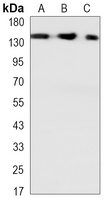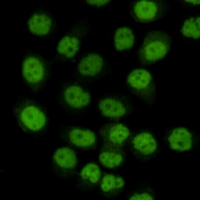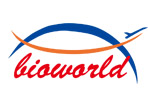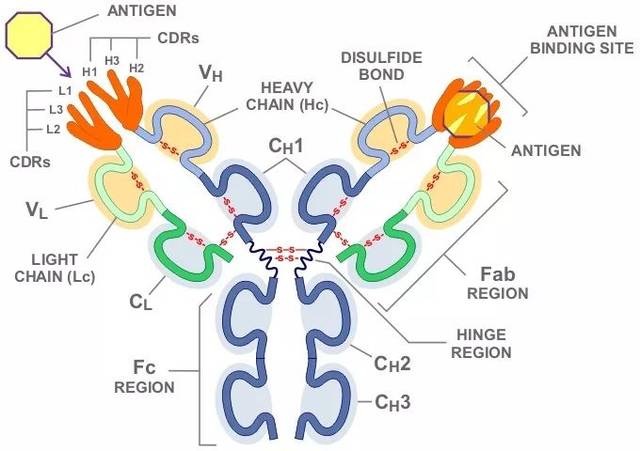Product Name :
SMC1A monoclonal antibody Background :
Structural maintenance of chromosomes 1 (SMC1) protein is a chromosomal protein member of the cohesin complex that enables sister chromatid cohesion and plays a role in DNA repair. ATM/NBS1-dependent phosphorylation of SMC1 occurs at Ser957 and Ser966 in response to ionizing radiation (IR) as part of the intra-S-phase DNA damage checkpoint . SMC1 phosphorylation is ATM-independent in cells subjected to other forms of DNA damage, including UV light and hydroxyurea treatment . While phosphorylation of SMC1 is required for activation of the IR-induced intra-S-phase checkpoint, the precise mechanism is not well understood and may involve a conformational change that affects SMC1-SMC3 interaction . The serine residue at 360 of SMC1 is phosphorylated in an ATM/ATR-dependent manner in response to DNA damage . Phospho-SMC1 (Ser360) Antibody is directed at a site that was identified at Cell Signaling Technology (CST) using PhosphoScan®, CST's LC-MS/MS platform for modification site discovery. Phosphorylation at Ser360 was discovered using an ATM/ATR substrate antibody and was shown to be induced by UV treatment. Please visit PhosphoSitePlus®, CST's modification site knowledgebase, at www.phosphosite.org for more information. Product :
Liquid in PBS containing 50% glycerol, 0.5% BSA and 0.02% sodium azide, pH 7.3. Storage&Stability :
Store at 4°C short term. Aliquot and store at -20°C long term. Avoid freeze-thaw cycles. Specificity :
Recognizes endogenous levels of SMC1A protein. Immunogen :
Purified recombinant human SMC1A(C-term.) protein fragments expressed in E.coli. Conjugate :
Unconjugated Modification :
Unmodification
SMC1A monoclonal antibody Background :
Structural maintenance of chromosomes 1 (SMC1) protein is a chromosomal protein member of the cohesin complex that enables sister chromatid cohesion and plays a role in DNA repair. ATM/NBS1-dependent phosphorylation of SMC1 occurs at Ser957 and Ser966 in response to ionizing radiation (IR) as part of the intra-S-phase DNA damage checkpoint . SMC1 phosphorylation is ATM-independent in cells subjected to other forms of DNA damage, including UV light and hydroxyurea treatment . While phosphorylation of SMC1 is required for activation of the IR-induced intra-S-phase checkpoint, the precise mechanism is not well understood and may involve a conformational change that affects SMC1-SMC3 interaction . The serine residue at 360 of SMC1 is phosphorylated in an ATM/ATR-dependent manner in response to DNA damage . Phospho-SMC1 (Ser360) Antibody is directed at a site that was identified at Cell Signaling Technology (CST) using PhosphoScan®, CST's LC-MS/MS platform for modification site discovery. Phosphorylation at Ser360 was discovered using an ATM/ATR substrate antibody and was shown to be induced by UV treatment. Please visit PhosphoSitePlus®, CST's modification site knowledgebase, at www.phosphosite.org for more information. Product :
Liquid in PBS containing 50% glycerol, 0.5% BSA and 0.02% sodium azide, pH 7.3. Storage&Stability :
Store at 4°C short term. Aliquot and store at -20°C long term. Avoid freeze-thaw cycles. Specificity :
Recognizes endogenous levels of SMC1A protein. Immunogen :
Purified recombinant human SMC1A(C-term.) protein fragments expressed in E.coli. Conjugate :
Unconjugated Modification :
Unmodification
-
 Western blot analysis of SMC1A expression in Molt4 (A), U87MG (B), Hela (C) whole cell lysates.
Western blot analysis of SMC1A expression in Molt4 (A), U87MG (B), Hela (C) whole cell lysates. -

Bioworld Biotech only provide peptides for our antibodies and do not provide additional peptide customization services.
Price/Size :
USD 368/1mg/vial
Tips:
For phospho antibody, we provide phospho peptide(0.5mg) and non-phospho peptide(0.5mg).Describe :
Blocking peptides are peptides that bind specifically to the target antibody and block antibody binding. These peptide usually contains the epitope recognized by the antibody. Antibodies bound to the blocking peptide no longer bind to the epitope on the target protein. This mechanism is useful when non-specific binding is an issue, for example, in Western blotting (WB) and Immunohistochemistry (IHC). By comparing the staining from the blocked antibody versus the antibody alone, one can see which staining is specific; Specific binding will be absent from the western blot or IHC performed with the neutralized antibody.Formula:
Synthetic peptide was lyophilized with 100% acetonitrile and is supplied as a powder. Reconstitute with 0.1 ml DI water for a final concentration of 10 mg/ml.The purity is >90%,tested by HPLC and MS.
Storage:
The freeze-dried powder is more stable. For short time at 2-8°C. For long term storage store at -20°C.
Note :
This product is for research use only (RUO only). Not for use in diagnostic or therapeutic procedures.
 SMC1A monoclonal antibody
SMC1A monoclonal antibody  Datasheet
Datasheet COA
COA MSDS
MSDS SHIP
SHIP